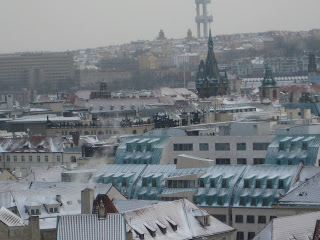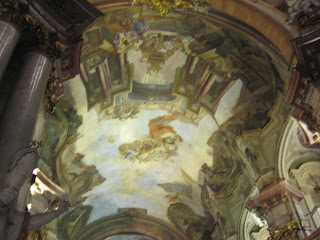Word of advice when riding on trains, try and figure out the language they make announcements in before boarding, otherwise you will be lost. My sister and I spent a good amount of the 5-hour train ride from Munich to Prague figuring out which stops were which and how to ask one of the conductor's directions. Needless to say, this was not an easy task and made our first impression of Prague a bad one.
Once we finally arrived to the train station and found a cab to take us to our hotel, we found ourselves in the middle of Old Town (yes, each of these cities has an "Old Town" and a "New Town"). Thankfully Eshani did a good job in booking a hotel that was central to where all the sites are and not in a seedy neighborhood. After dropping off our bags, taking a small nap, showering, and getting bundled up for the below freezing temperatures, we strolled outside to the quaint Old Town Center and were met by the Prague Astronomical Clock, or Orloj.
This beautiful structure has been giving those strolling by it the time since the Medieval Age. The Orloj is composed of three main components: the astronomical dial, representing the position of the Sun and Moon in the sky and displaying various astronomical details; "The Walk of the Apostles", a clockwork hourly show of figures of the Apostles and other moving sculptures; and a calendar dial with medallions representing the months. Although it is 10x better to see during the day, because one cannot fully grasp the ornate details at night, it was still a wonderful opening image of Prague and truly depicts the beauty of the city.
Now Prague, like most European cities, takes Euro notes, but it also still mainly accepts Czech Krowns as their main form of currency. We took out 1000 Czech Krowns thinking that would last us three-to-four days, but we soon found out otherwise. Our dinner that night was 800 Krowns - boom, there goes our money. After our initial shock, we came to the realization of the exchange rate (stupid mistake on our part) and promptly withdrew more money. This initial shell-shock drove us to go home and straight to bed.
The next morning we awoke and I had the opportunity to go to the top of the Astronomical Clock. At the top I was able to have a three-hundred and sixty degree view of the entire city - it was breath-taking.
After that we walked into the Jewish Quarter (Josefov) which after many years is now considered part of Prague. During the Nazi take-over of Czechoslovakia, the Jews were segregated into the ghetto in order to cause further alienation. Conditions, of course, were dingy and abysmal, causing death and severe famine. The Jewish population, however, overcame great adversity and the Quarter is now one of the best parts of the city. Surrounded by five synagogues a cemetery and every designer store imaginable, Josefov is in the middle of the Old Town and is a wonderful place to explore the Jewish culture.
Currently Josefov is overbuilt with buildings from the beginning of the 20th century, so it is difficult to appreciate exactly what the old quarter was like when it was said to have over 18,000 inhabitants. Immediately after walking around Josefov we went back into the center of Old Town and visited Tyne Church - one of the many large churches in Prague. Tyne Church, like most of the other churches we visited and would visit, did not allow photography, so I can't show you the incredible detail and magnificence of the structure; hopefully you can take my word for it. Being a Hindu I thought visiting churches would be boring, but my "artistic" side made me think otherwise. Tyne was awe-inspiring and an extremely solemn place.
That night, we decided to brave the elements and see Charles Bridge. The Charles Bridge is probably the most recognizable site in Prague as it is in every movie filmed in the Czech Republic. The bridge is the only means of crossing the River Vltava and it connects Prague Castle and Old Town. I was marveled by how many gargoyles and statues aligned the bridge (I thought it was just a plain bridge). The spectacular view of the city trumped the frigid weather and it was definitely worth it to see at night.
Shortly thereafter, we went to a restaurant that served me one of the best meals I have ever had in my life - U Parlamentu. When we sat down we were immediately given Pilsner Urquell, a pale lager originally made in the town Pilsen which is a few miles away from Prague. One of the gentlemen at the restaurant described it as the best beer in the world. I asked him where else he had been and he said he never left Prague - shocker. As for dinner, I had some type of pork with spinach and dumplings. I'm not sure why it was so good, but the taste of the spices and ingredients was perfect. We got a kick out of the rest of the evening when the same man who spoke so highly of Pilsner introduced us to his friend who spoke fluent Spanish. After a few beers in me I immediately became friends with him and spoke to him in Spanish for at least 45 minutes, to the dismay of my sister who was annoyingly bored. He was a film producer in Prague but he traveled to Latin America to shoot commercials. It was there that he learned, and eventually became fluent in, Spanish. We eventually parted ways but not until he bought my sister and I a "round" and we exchanged numerous stories about how Latin America is a wonderful place.
The next day we made our way across The Charles Bridge.
Other than gargoyles and statues that bridge is filled with happy couples strolling by and artists selling paintings of the city. My photographs don't do the city justice, their paintings did, however, and that is why we bought my parents one.
Prague Castle is situated in what is known as Lesser Town (the reason for this I did not pick-up). There weren't as many people in this area which surprised me because the Castle is a huge tourist attraction, but the slippery hills and inclines soon made me realized why. Walking up to the castle was an adventure in itself - dangerous and tough. Once we got to the top, however, the view was breathtaking (which is bad because we didn't have much breath left from the hike up). We were able to see the entire city from the top, just like at the top of the Astronomical clock and the complex of the castle, which is the largest in the world.
It is so large that we spent two days touring it - here are the details:
The buildings inside the complex - St. George's Convent, the Archbishop of Prague's estate, and several others are all relics of the Bohemian Kings and the Holy Roman Empire. Furthermore, the President of the Czech Republic also has an office inside the complex, which kept me occupied, of course, but we did not get a chance to see him. What did impress me was St. Vitus Cathedral, the seat of the Archbishop of Prague and dedicated to Vitus, who died as a martyr. Walking inside St. Vitus is like walking into a quintessentially gothic building. It's size and grandiose nature help explain why it is the biggest and most important church in the country. What's even more fascinating is that some of the Bohemian Kings were buried there - having Holy Roman Emperors under my feet was pretty cool. What was even more exciting was in the castle itself. I walked in the room were the Defenestration of Prague occurred. This was the event in 1618 that was central to the start of the Thirty Years' War. History tells us that Protestants, angered by the election of Ferdinand (Duke of Styria and a Catholic), threw his Reagents out of the window because their rights were being limited. (Defenestration is the act of throwing somebody of the window). Funny enough, there were signs that prohibited this event from occurring now.
Two other things that made Prague memorable were St. Nicholas Church and dinner on the last night. To begin, St. Nicholas is the home to the baroque organ of a young composer in 1787 - Wolfgang Amadeus Mozart. In one of his first major concerts he apparently used that organ to entertain the general populous, but more importantly the King at the time. The interior of St. Nicholas Church is decorated with statues, paintings and frescoes by leading artists of the day. Particularly impressive is a fresco of the Celebration of the Holy Trinity by Franz Palko, which fills the 70m high dome.
The second event was dinner in Lesser Town at a pub that was filled with lively personalities. This, however, was not what made the dinner memorable, my meal was. I ordered the knuckle of a pig - gross - and ate a good amount of it. It was pretty good in the beginning but became very filling afterwards. I ended up wrapping it and giving it to a homeless man. All in all Prague was a wonderful city. I recommend it for anyone who loves gothic architecture and painting from the same period. In addition, I recommend it for any history buffs who enjoy the HRE and Czech culture.




















































